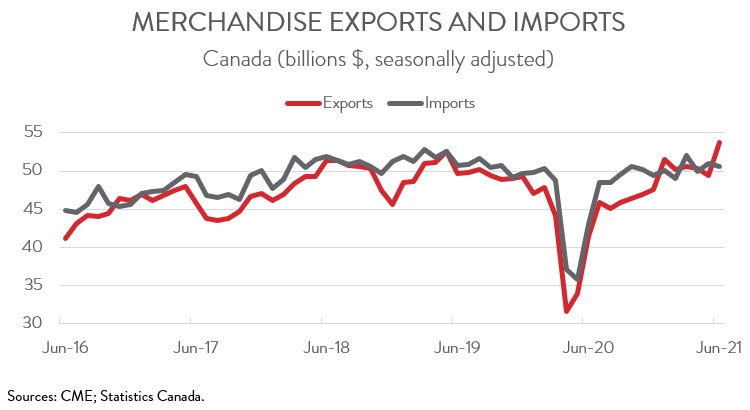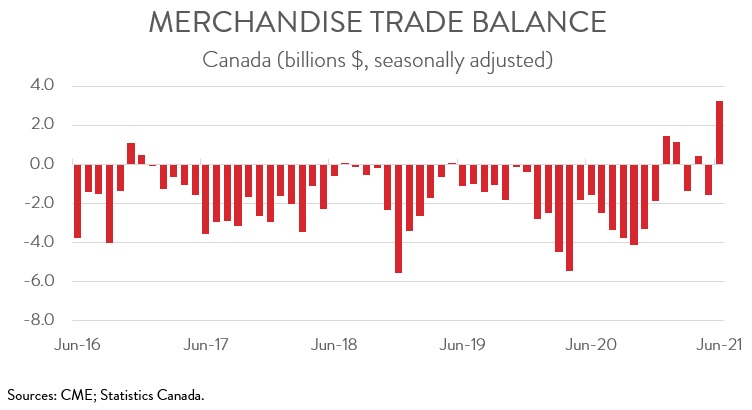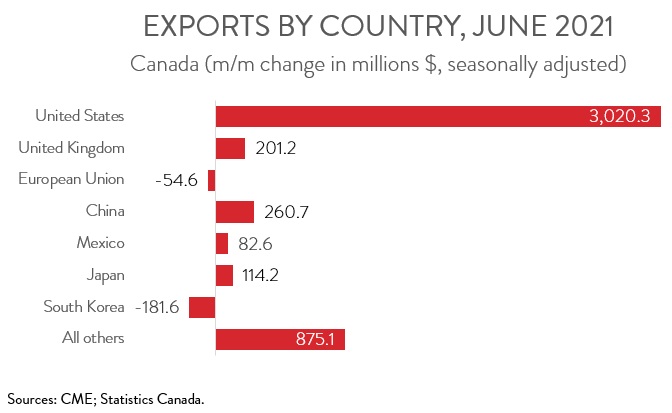International Trade
Merchandise Trade
JUNE 2021
Surging Exports Drive $3.2-Billion Trade Surplus in June
HIGHLIGHTS
- Canadian merchandise exports surged 8.7% to $53.8 billion in June, while merchandise imports fell 1.0% to $50.5 billion.
- Canada’s merchandise trade balance returned to a surplus position in June, reaching $3.2 billion.
- In volume terms, real exports advanced 7.0%, while real imports declined 2.2%.
- The increase in exports spanned 9 of 11 major commodity groups, with exports of energy products accounting for nearly half of the total gain.
- Exports to the U.S. rose 8.2% to a record $39.7 billion in June. Exports to the rest of the world were also up strongly (+10.2%).
- Despite the robust June numbers, merchandise exports in constant dollars plunged 4.7% in the second quarter, while imports in constant dollars were down a comparatively mild 0.6%. This indicates that merchandise trade acted as a drag on real GDP growth in the second quarter. While trade activity is expected to pick up in the second half of the year, the Delta variant and ongoing supply chain challenges pose significant risks to the outlook.
MERCHANDISE EXPORTS SURGE 8.7% IN JUNE
Canadian merchandise exports surged 8.7% to $53.8 billion in June, while merchandise imports fell 1.0% to $50.5 billion. In volume terms, the story was just as impressive: real exports advanced 7.0%, while real imports declined 2.2%.

Despite the robust June numbers, merchandise exports in constant dollars plunged 4.7% in the second quarter, while import in constant dollars were down a comparatively mild 0.6%. This indicates that merchandise trade acted as a drag on real GDP growth in the second quarter. While trade activity is expected to pick up in the second half of the year, the Delta variant and ongoing supply chain challenges pose significant risks to the outlook.
TRADE BALANCE RETURNS TO SUPRLUS POSITION
Canada’s merchandise trade balance returned to a surplus position in June, reaching $3.2 billion. As a result, Canada has posted trade surpluses in four of the first six months of 2021. Breaking the June numbers down, our trade surplus with the U.S. widened from $5.9 billion in May to $8.3 billion in June, while Canada’s trade deficit with the rest of the world narrowed from $7.5 billion to $5.1 billion. Our surplus with the U.S. was the largest since August 2008.

INCREASE DRIVEN BY HIGHER EXPORTS OF ENERGY PRODUCTS
The increase in exports spanned 9 of 11 major commodity groups. Exports of energy products increased a robust 22.9% to $11.3 billion, the highest level since March 2019. The $2.1 billion rise accounted for almost half of the gain in total exports.
Exports of motor vehicles and parts rose 14.9% to $5.9 billion in June. While the industry has been hit hard by the global shortage of semiconductors, the impact of this shortage appeared to have eased slightly in June. As a result, work stoppages at Canadian assembly plants in June were less severe than in April and May. Nevertheless, despite the gain, exports of motor vehicle and parts in June were 21.3% lower than in February 2020.
Exports of metal and non-metallic mineral products increased 12.7% in June to a record $6.7 billion. Exports of unwrought gold, silver, and platinum group metals, and their alloys—a category mainly composed of gold—contributed the most to the gain.
On the negative side, exports of aircraft and other transportation equipment and parts fell 20.7% to $1.8 billion in June. With this decline, exports in June were 27.1% below the pre-pandemic level, making it the product category furthest from a full recovery.

EXPORTS TO THE U.S. HIT A RECORD HIGH
Canada’s exports to the U.S. rose 8.2% to a record $39.7 billion in June. The gain was attributable to higher exports of crude oil and of passenger cars and light trucks. Exports to the rest of the world also increased rapidly, up 10.2% to $14.0 billion. Among Canada’s major non-U.S. trading partners, exports to China, the United Kingdom, Japan, and Mexico were up on the month, while exports to the European Union and South Korea were down. The increase in exports to the U.K. was mainly driven by higher exports of gold.
